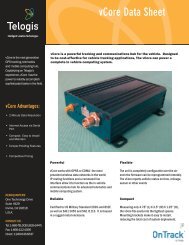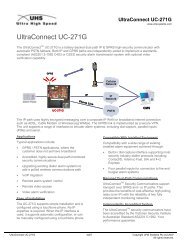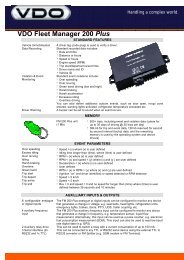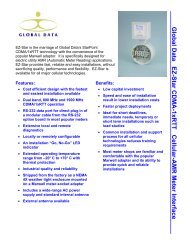Hardware Interface Description - KORE Telematics
Hardware Interface Description - KORE Telematics
Hardware Interface Description - KORE Telematics
Create successful ePaper yourself
Turn your PDF publications into a flip-book with our unique Google optimized e-Paper software.
XT55/56 <strong>Hardware</strong> <strong>Interface</strong> <strong>Description</strong><br />
Confidential / Released<br />
s<br />
4.10 Start-up procedures<br />
The start-up strategy of the XT55/56 GPS part depends on the last position, current time and<br />
ephemeris data, that the receiver has stored the external SRAM memory. There are three<br />
different start-up procedures:<br />
4.10.1 Coldstart<br />
The coldstart takes place when the receiver has no knowledge of its last position or time. In<br />
this case the GPS RTC has not been running and no valid ephemeris data or almanac data<br />
is available (The receiver has never been navigating or no battery backup memory<br />
available).<br />
4.10.2 Warmstart<br />
This start-up procedure is performed whenever the receiver is able to use the valid almanac<br />
data, and has not in an important manner moved since the last valid position calculation. This<br />
procedure starts if the receiver has been shut off for more than 2 hours, but the last position,<br />
time and almanac are still acknowledged. This procedure is able to announce the current<br />
visible satellites in advance. However, since ephemeris data are not available or cannot<br />
longer be used, the receiver has to wait for the ephemeris broadcast to complete.<br />
4.10.3 Hotstart<br />
Hotstart is performed whenever the receiver still has access to valid ephemeris data and<br />
exact time. This procedure starts if the receiver has been shut off for less than 2 hours and<br />
the GPS RTC has been running during that time. Furthermore, during the previous session,<br />
the receiver must have been navigating (to allow it to decode and store ephemeris data).<br />
In Hotstart, the receiver can announce in advance the currently visible satellites, and is<br />
therefore able to quickly obtain and track the signal. Due to the fact that ephemeris is already<br />
known, there is no need to wait for the ephemeris broadcast to complete.<br />
XT55/56_hd_v02.06a Page 79 of 125 17.12.2004
















